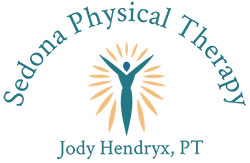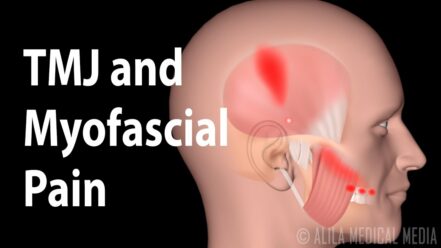The topic is temporomandibular joint disorders. More commonly referred to as “tmj”, the disorder, with its variety of symptoms, received national attention in the 1980’s as the new “dumping” diagnosis. In some social circles it was even fashionable or trendy to have TMJ. Myofascial Release has been found to be an effective treatment for TMJ.
Nevertheless, conservative estimates figure 10 million Americans have tmj, 75% of which are women between the ages of 20-50 (similar statistics are seen for the incidence of fybromyalgia). Dr. Harold Gelb, a leading tmj specialist, postulates tmj is a primary initiating factor in 80% of all chronic pain disorders and may be the underlying cause of many chronic pain conditions. A myofascial release principle in line with the essence of Dr. Gelb’s pain theory is “find the pain, look elsewhere for the cause”, as the fascial web causes many pain patterns to be referred from the primary site.
What is the temporomandibular joint?
Located in front of the ear canal on either side of the head, the joint connects the lower jaw (mandible) to the temporal bone of the skull. The joint allows for opening, closing and side to side movements involved in chewing, speaking and yawning. The primary muscles controlling these movements and subsequent muscular dysfunctions are the masseter, temporalis, and pterygoid muscles.
What causes TMJ disorders?
Known causes or contributing factors of TMJ include direct injury to the jaw, face or head from a heavyblow or whiplash. Other direct intrinsic factors include clenching or grinding the teeth, arthritis,dislocation of disc, and psycho-emotional stress. indirect or extrinsic factors can include trauma to anywhere else in the body, poor pelvic alignment, muscle/ postural imbalances, poor oral habits and/or
body mechanics at home and work. since one tmj cannot move independently of the other, it is considered a “bilateral joint”. Being a bilateral joint makes it more prone to and directly affected by fascial misalignments. for example, well over half of all TMJ patients seen at Verde Valley Myofascial Release have some form of pelvic misalignment as well.
What are the symptoms of TMJ?
Common symptoms of tmj include:
- Pain or tenderness in the face, neck, shoulders, jaw joint
- Pain, clicking and/or popping when opening or closing the jaw
- A tired feeling in the face
- Jaw locking /difficulty opening or closing mouth
- Headaches, ringing in the ears, dizziness, ear pain, teeth pain
- Muscle spasms, extremity numbness, backaches
- Difficulty sleeping, fatigue, frustration, anger, and depression
What are the treatment options for TMJ?
Treatment for tmj ranges from various conservative care protocols to surgery. given the vast array of symptoms and etiologies, treatment of tmj is a case by case protocol and should take into account each individual’s physical, mental, emotional and spiritual practices.
What is the philosophy for treatment and management of TMJ?
Our “hands on” approach focuses on structural and fascial misalignments and the resulting compensations within the body. Our therapist’s advanced manual and didactic skills are well suited in evaluating and treating the many components involved in creating tmj symptoms. from your initial evaluation until your discharge, our therapists constantly monitor the progress of your changing
postural and movement patterns. We are trained to help facilitate positive change in postural and structural imbalances, core stability, body mechanics, harmful oral habits and home stretch and exercise routines. A skilled assessment of your particular patterns is essential to create an individualized protocol to remediate your tmj dysfunction.
Things you can do to help your own symptoms:
1. Evaluate and improve stress, diet and exercise. it has been said “the best exercise is the one you do!” and therefore we encourage you to “do” something daily that has a positive impact on stress, diet and overall wellness of the body/ mind. Some find it very helpful to do a few stretches throughout the day. in selecting an exercise routine good for you we suggest activities that promote good body mechanics, open and expand the body, increase oxygen and cardiovascular performance and decrease stress.
2. Use manual techniques to treat yourself. Here is a sample self treatment protocol you can do in a few minute at home or the office:
- Stand with four corners of feet pressing down and toes forward, tailbone slightly under, abdomen relaxed, chest lifted, shoulders relaxed, head level, relaxed and balanced on spine. (in yoga this position is called “mountain pose” and when done correctly will help you feel better all over and ideally become a habit and lead to better body mechanics.)
- Standing in mountain pose gently, rotate neck in a clockwise pain free position. repeat in counterclockwise direction.
- Continue in mountain pose performing shoulder shrugs, shoulder rolls in forward and backward directions. Finish with pulling shoulder blades together and downward and then raising arms overhead.
- Sitting with feet flat on floor, knees at 90 degrees, torso in mountain pose place hands on face just in front of ears and gently massage up into temples and down jaw line (spend extra time at any sore areas). Having hands along the bottom jaw line, gently push up, compressing the tmj. Hold 1-2 minutes. Next, switch directions, gently pulling down towards your feet, distracting the jaw at the tmj
- without sliding on the skin. Note that jaw position for these stretches and in general at most times should be with lips together, teeth slightly apart, lower jaw relaxed and tongue resting on the roof of the mouth.
3. Get regular treatments at Verde Valley Myofascial Release – whether you are symptomatic or not, regular body work is essential to maintain our health and well being. For acute/chronic symptoms, let our advanced therapists evaluate you and create a treatment protocol just for you. For general maintenance, let our gifted massage therapists work out your daily stress through our “advanced massage therapy” practice.
Jody Hendryx, PT

